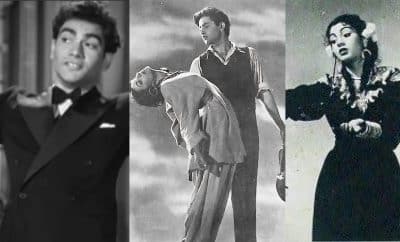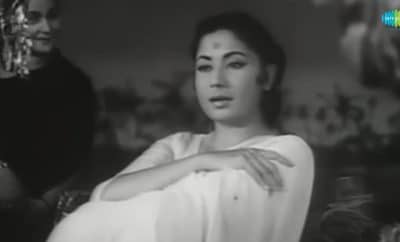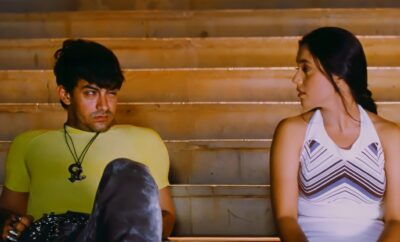Legends
Bhanu Athaiya – The Queen of Costume Design in Hindi Film Industry
An artist is born
Bhanumati Rajopadhye Athaiya, better known as Bhanu Athaiya was born in a family that traces a 2000 yrs old history. Her forefather who arrived in Maharashtra, was a Sanskrit scholar of his times. Bhanu Athaiya grew up under the influence of her ancestral lineage and the modern style of upbringing by her father, whose family was settled in Kolhapur. She belonged to the Pandit lineage and lived in a 300 years old palatial ancestral house.
Though born during the British Raj, she grew up in an environment where Indian culture met western influence. Religious festivals and traditions were celebrated in the most perfect possible manner in her household. Her regular route to the school passed through the Mahalaxmi temple of Kolhapur, where she enjoyed looking at the architecture of the temple and gazing at jewellery of young brides who came with their families to seek blessings from the goddess. At home, her father would study painting techniques of the British academic style. He was also a photographer, who had his own dark room. Photography was a rare skill in those times. It can be said, that Bhanu Athiaya grew up on the confluence of old and new. Her upbringing was seeped in art, music, drama, culture, religion, European art and modern techniques in the field of photography and talkies.
In her own words, “Kolhapur was also known as Kalapur, the City of the Arts. This formerly princely state was once among the most important on the map of royal India. I was a witness to this grandeur and pageantry at every step of my life.”
The journey of an artist to doyenne of costume design
As a young artist who focused on academics and art, Bhanu was influenced by the personality of Hima Devi, who presented ‘Red Oleanders’ in the Palace theatre in Kolhapur. It was she who taught ‘Geetanjali’ to her.
Bhanu’s father, the late Shri. Annasaheb Rajopadhye, introduced her to western cinema. She was impressed by Greta Garbo’s military style dress in ‘Queen Christina’. Baburao Painter, a friend of Annasaheb, had put Kolhapur on the film map of India. Annasaheb himself had assisted Baburao in few of his films. Baburao had made his own silent films alongside painting the backdrops of Bal Gandharva’s plays. Bhanu had the privilege to see his work and attend shoots that happened in Kolhapur.
With the encouragement by her art teacher in Kolhapur, her mother’s support, and Hima Devi’s affection, Bhanu Athaiya started her career as a student of Art at Sir J.J. School of Arts in Bombay. An interesting twist of destiny, and she landed up as a fashion illustrator at a women’s magazine ‘Fashion and Beauty’, who’s assistant editor was Meera Devi, Hima Devi’s mother. At that time, it was a big decision for her to make – whether to continue painting or to take up fashion designing. The latter was a practical decision she took, just so she could stand on her own feet.
A new door opened to her with the launch of ‘Eve’s Weekly’. She contributed to the cover page for its Independence Day issue where she sketched a black-and-white etching of Gandhiji and Kasturba, with the Indian National flag fluttering on top. With her sketches on fashion appearing every Saturday in the weekly, she started becoming popular amongst the big names of the Hindi Film Industry. On requests by readers, the editor of the weekly opened a boutique where she would create designs for her regular clients like Kamini Kaushal. She even designed costumes for her films. Her first film project was ‘Aas’ where Kamini Kaushal played a modern girl. Hardly did she know that this was just the beginning of a huge success of over five decades of costume designing.
Soon, film tycoons like B. R. Chopra, Ramanand Sagar and the young Yash Chopra began visiting the boutique. The conscious decision from being a fashion designer to a costume designer was something that was a result of a slow transition that just happened in Bhanu’s career, and she went with the flow.
As Bhanu Athaiya says, “India was turning a new page in its history. Even though we had not yet attained independence, there was a growing awareness among people about Indian culture and heritage, Western influence was on the wane. Women wanted inspiration for Indian styles and I was in the right place at the right time.”
Mud mud ke na dekh
The 50’s saw a sort of return of the western style of costumes in Hindi cinema with the biggest showman of the film industry dreaming big. Who else would have imagined hiring the services of a designer to design costumes for a vamp, but Raj Kapoor! He called upon Bhanu Athiya at the request of Nargis, who was her regular client, to create designs for the role of a vamp, which Nadira was playing in the film Shri 420.
The dress of a cabaret dancer was the talk of the town. It gave the bold and sensuous looking character of Nadira a much glamourous look. The flowy gown with an open shoulder, covered just with a cape of net material, pulled over by beads towards the neckline and held by a choker with lovely tassels falling behind the neck, set a perfect example of breaking the old norm. The same song has yet another costume of Nadira in a body hugging mermaid style outfit with a flared portion below the knees made using net material. The bouffant hairstyle, the bare shouldered gown and the cape flowing down from the top of the hair do till below the shoulders gave the character of a mere vamp a look of the century!
Why won’t it be a headturner?!
The huge success of Shri 420 and the ability of a designer to think about the character first and the fashion later, made Bhanu Athiaya never look back in her career.
https://youtu.be/2yAGsNt_7R0
Again, another of R.K. Banner’s super hit movie had the touch of Bhanu’s creativity. It was classy, almost not recognisable at times – costumes designed for Vaijayantimala. Though the world may associate her and Sangam with the costumes she made for the vivacious look of Vaijayantimala in the song ‘Main kaa karoon Raam mujhe buddha mil gaya’, it was her classy look in the songs ‘yeh mera prem patra padhkar’ and ‘O mere sanam’. She wears a simple white silk saree with a red border in ‘yeh mera prem patra’. The requirement of the song was such that a woman realises that her love is reciprocated by the man she adores. The costume had to have a simple yet classy look. The purity in love is depicted in the choice of white colour. The red at the border of the saree gives it a hint of burning desire to be loved.
‘O mere sanam’ is a classic song. White colour, as quoted by many, has been a colour for all occasions in the Hindi film industry. Pearl white tone in silk looks royal. Vaijayanti Mala is shown in a saree in pale pearl white. The fabric is ‘crepe de chine’ with ’tilley ka kam’ done on it. She looks extremely graceful in the saree that is pinned properly enough for her to take the ‘chakkar’ at the end of the scene which is the climax of the song.
Period films
Amrapali was a pathbreaker film in many aspects. It was an ambitious project of F.C. Mehra (producer) and Lekh Tandon (director) who appointed Bhanu Athaiya as the costume designer for the movie. And what a splendid job she did! She turned to Ajanta and Ellora caves for drawing inspiration, thus imparting the required ‘period’ touch to the costumes.
All the costumes of the movie had to resemble the period in which the movie was set. So, we see bright colors for costumes worn by the royals/nobles. The common folk wore clothes with lighter hues. But Bhanu ji played with the designs of costumes worn by the common female dancers. Here, we see a ‘kanchuli’ dyed with natural dyes having tribal motifs worn by Bela Bose. When I come to think of costumes in hindi cinema, there’s no one till date who can even stand next to Bhanu ji. Her detailing for any frame of the scene was par excellence. All this in an era where films had very less budget as compared to what we see today.
The tribal motif: Amrapali was the royal courtesan of Vaishali – Vaishali ki Nagarvadhu. The kingdom of Vaishali was the capital of the Licchavi tribe. So, though the royals and nobles would be seen clad in silk robes with bright colours, the common men and women dressed themselves with clothes that suited their tribe. The thought of Bhanu Athaiya, who went into making costumes of Amrapali, made the film a classic.
Chaudvin ka Chand was a muslim drama based on the nawabi culture of Uttar Pradesh. Playing with the ideas that suited a certain community was a challenging task. Bhanu, as usual, did her research by understanding the culture of that community. Waheeda Rehman’s outfit on her first night with her husband was the feature of the song ‘Chaudhvin ka Chand ho ya aftab ho’. Her beauty was to be seen and admired only by her husband. But, how could the audience experience this fact of the culture? So, Bhanu used the net material to half cover and half disclose her face. Beauty can be appreciated only when it is partially hidden. What a splendid play of light and shadow in the song? Brought forth not just by the camera person, but complemented by the use of fabrics.
The movie premiered in Calcutta, and Guru Dutt wanted Bhanu to travel with the crew. Hardly did she know the purpose of all this – researching for his next period film – Sahib, Bibi aur Ghulam.
‘Piya aiso jiya mein samay gayo’ sets designers of today think what a lady single handedly can create and give that classy look to the larger than life character of ‘Choti bahu’. A single meet with Meena Kumari before the film was made, and she having remarked about the puffiness of the saree drape of jamdani sarees, made Bhanu invent something that not only retained the classiness of the jamdani design, but made the actress feel comfortable wearing it. She attached the borders of the jamdani saree to a net material and hand embroidered motifs that went along with the design pattern of the border. And of course the jaw dropping look of Choti bahu draped in the classic banarasi tanchoi saree is etched on everyone’s mind.
Making songs a journey of colours and style
The Hindi film industry has always been a major influencer of trends in fashion of any given era. It was always a place where we saw new experiments made by either the producers, directors or if affordable, even a costume designer. Costumes in any given film were subject centric. They had to match the milieu of the story. Dresses, sarees, regional costumes made the characters of any film stronger.
Bhanu Athaiya made the heroines of the Hindi film industry look gorgeous and apt for the character they played. Waqt was the first multi starrer movie of the Hindi film industry. It was produced by B. R. Chopra and directed by Yash Chopra. The role of Yash Chopra in spending on costumes in his films can be seen significantly in every scene of the film. The movie portrayed the lifestyle of the emerging upper class and the privileged. It also had to showcase the costumes of the rich Punjabi-Sindhi families at the beginning of the film. Bhanu Athaiya brought her career best in designing costumes for the rich younger generation of upper class that Yash Chopra exactly wanted. Fashion trends were created with this film. Young girls wished to dress up like Sadhana and Sharmila – the tight fitted kurta and salwar or a churidar became a trend.
When we talk about Bhanu Athaiya’s contribution to the Hindi film industry, there’s one film which can’t be forgotten – Guide.
Waheeda Rehman has the best dance performances in this film than any other. Every dance sequence had to suit the situation and the mood of the song. She dances gracefully in a nine yard saree tucked and pinned beautifully, yet maintaining the grace of the drape in the section ‘un bin aayi kaisi Diwali’ of the song and dance sequence ‘piya tose naina laage re’.
Bhanu Athaiya has to her credit an amazing repertoire of 130 films and has worked with every director and producer of consequence, including Raj Kapoor, Guru Dutt, B.R. Chopra, Yash Chopra, F.C. Mehra, Sunil Dutt, Dev Anand, Randhir Kapoor and Ashutosh Gowariker. She has styled all actresses right from Kamini Kaushal to Waheeda Rehman to Zeenat Aman to Dimple Kapadia to Gracy Singh.
She’s the only costume designer who won Indian cinema the highest acclaim in the international arena – an Oscar for the film ‘Gandhi’ by Richard Attenborough. Here, it is also necessary for all handloom lovers of today to know that she was the former Chairperson of Maharashtra State Handloom Council. I can openly say today that nobody matches her talent and body of work in giving handloom and the textile heritage of India centre-stage. She recreated designs from Ajanta caves and even worked on natural dyes. The immense efforts she put in for ‘Gandhi’ are visible if the film is watched frame by frame.
In the words of Lord Richard Attenborough –
We were indeed fortunate that Bhanu agreed to join our team. She is the revered doyenne of Indian costume designers and, as I’d hoped, her unparalleled knowledge of the different styles, fabrics and colours worn in every region of the sub-continent added immeasurably to the veracity of our film…
Costume designing is about giving an actor absolute confidence in the character he or she is to inhabit, about creating a mood and transporting the audience to a different era or place. It requires organisation, artistry, discipline, expertise, imagination and, more often than not, many hours of research.




Nandana
May 1, 2023 at 11:58 am
What a wonderful and informative article! It made a very interesting reading. Great job, Sharvari!
Sharvari Khatavkar
May 2, 2023 at 12:08 pm
Thank you dear!
Neeta Bhansali
May 2, 2023 at 8:27 am
A very well-written article. Very informative.
Sharvari Khatavkar
May 2, 2023 at 12:09 pm
Thank you dear!
Madhu Kelkar
May 2, 2023 at 8:33 am
A very interesting article from the word go. It’s crisp, racy, informative and insightful. Well done Sharvari! We look forward to more such pieces.
Sharvari Khatavkar
May 2, 2023 at 12:10 pm
I’m so thrilled by this compliment! Thanks!!
Varsha
May 2, 2023 at 9:23 am
An interesting read on the journey of a star designer. Her early life and her foray into costume designing for films is well documented.
Sharvari Khatavkar
May 2, 2023 at 12:10 pm
Thank you so much!!!!
Manek Premchand
May 2, 2023 at 9:49 am
This is a very well researched and written essay on a remarkable woman. Your love for–and understanding of–costumes and fabrics makes you the idea person to have explored this subject. Please continue to use your learning to illuminate the minds of people who want to know more ??
Sharvari Khatavkar
May 2, 2023 at 12:13 pm
Sir, it is only because of you that I started off with the subject of ‘Costumes in Hindi film music’. Your support means a lot. It was kind of Deepa to entrust me with this job for TheSongpedia. I am so happy to have received the ‘shabashi’ from you!
Monica Kar
May 12, 2023 at 10:40 pm
I finally got to read this – as usual, I learn so much from the posts you write, Sharvari – but especially this one! That bit about the Jamdani in Sahib, Bibi aur Ghulam was a complete surprise! I wanted more at the end of the essay! More on Bhanu Athaiya and more from Sharvari Khatavkar! You write with knowledge, research and passion. May the ink in your creative pen never dry. Thanks also to Deepa’s TheSongPedia for asking you to contribute here. Dher sara ashirwad aur pyar!